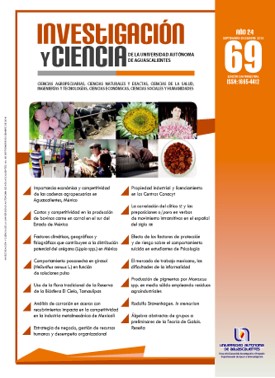Estrategia de negocio, gestión de recursos humanos y desempeño organizacional
DOI:
https://doi.org/10.33064/iycuaa2016691870Palabras clave:
estrategia, gestión, recurso humano, desempeño, prácticas, PyMEResumen
Dentro del enfoque estratégico organizacional, en los últimos años se ha enfatizado el papel de los recursos humanos en el establecimiento de la estrategia competitiva, el crecimiento organizacional y la creación de valor. Por ello, el presente estudio busca explorar el vínculo entre la estrategia de negocio, las prácticas de gestión de recursos humanos (GRH) y el desempeño organizacional, en una muestra de PyME del sector de manufactura del estado de Querétaro. Los resultados muestran que existen diferencias en las prácticas de GRH en función de la estrategia de negocio adoptada, los valores más altos se encontraron en estrategias
prospectoras y analizadoras. Igualmente, se halla que estas estrategias y prácticas están relacionadas positivamente e inciden de manera significativa en el desempeño organizacional. Se concluye que implementar las mismas es importante para crear y mantener el capital humano que permita obtener un mejor desempeño y alcanzar una ventaja competitiva.
Descargas
Citas
• ALTARAWNEH, I. I. Strategic human resources management and its impact on performance: the case from Saudi Arabia. International Journal of Business Management and Economic Research, 7(1): 486-503, 2016.
• ANDERSEN, T. J. y MINBAEVA, D. The role of human resource management in strategy making. Human Resource Management, 52(5): 809-827, 2013.
• BARNEY, J. y WRIGHT, P. On becoming a strategic partner: the role of human resources in gaining competitive advantage. Human Resource Management, 37(1): 31-46, 1998.
• HAMID, J. Strategic human resource management and performance: the universalistic approach-case of Tunisia. Journal of Business Studies Quarterly, 5(2): 184-201, 2013.
• HO, P. Analysis of competitive environments, business strategies, and performance in Hong Kong’s construction industry. Journal of Management in Engineering, 32(2): 1-14, 2016.
• HUSELID, M. A. et al. Technical and strategic human resources management effectiveness as determinants of firm performance. Academy of Management Journal, 40(1): 171-188, 1997.
• KARAMI, A. et al. The influence of HR practices on business strategy and firm performance: the case of banking industry in Iran. The IUP Journal of Management Research, 14(1): 30-53, 2015.
• KATOU, A. A. y BUDHWAR, P. S. Causal relationship between HRM policies and organizational performance: evidence from the greek manufacturing sector. European Management Journal, 28(1): 25-39, 2010.
• LEE, F. H. et al. The relationship between human resource management from steel practices, business strategy and firm performance: evidence industry in Taiwan. The international Journal of Human Resource Management, 21(9): 1351-1372, 2010.
• LOO SEE, B. y LEAP HAN, L. Human resource management best practices and firm performance: a universalistic perspective approach. Serbian Journal of Management, 8(2): 155-167, 2013.
• MICHIE, J. y SHEEHAN, M. Human resource management and corporate performance: evidence from UK and US small firms. En R. Barrett & S. Mayson (Eds.), International Handbook of Entrepreneurship and HRM (137-164). Cheltenham: Edward Elgar, 2008.
• MILES, R. E. y SNOW, C. C. Designing strategic human resource systems. Organizational Dynamics, 31(1): 36-52, 1984.
• MILES, R. E. et al. Organizational strategy, structure, and process. New York, US: McGraw-Hill, 1978.
• PECK, S. R. Exploring the Link between Organizational Strategy and the Employment Relationship: The Role of Human Resources Policies. Journal of Management Studies, 31(5): 715-736, 1994.
• PEREGRINO DE BRITO, R. y BARBOSA DE OLIVEIRA, L. The Relationship between Human Resource Management and Organizational Performance. Brazilian Business Review, 13(3): 90–110, 2016.
• PORTER, M. E. The Competitive Advantage: Creating and Sustaining Superior Performance. NY, US: Free Press, 1985.
• RAZOUK, A. A. High-performance work systems and performance of french small- and medium-sized enterprises: examining causal order. International Journal of Human Resource Management, 22(2): 311–330, 2011.
• SCHULER R. S. y JACKSON, S. E. Linking competitive strategies with human resource management practices. Academy of Management Executive, 1(3): 207-219, 1987.
• SHEEHAN, M. Human resource management and performance: evidence from small and medium sized firms. International Small Business Journal, 32(5): 545-570, 2014.
• ÚBEDA GARCÍA, M. et al. Training policy and organizational performance in the spanish hotel industry. The International Journal of Human Resource Management, 24(15): 2851-2875, 2013.
• VENKATRAMAN, N. Strategic orientation of business enterprises: the construct, dimensionality and measurement. Management Science, 35(8): 942-962, 1989.
• VORHIES, W. D. y MORGAN, N. A. Benchmarking marketing capabilities for sustainable competitive advantage. Journal of Marketing, 69(1): 80-94, 2005.
• WANGITHI WAIGANJO, E. et al. Relationship between strategic human resource management and firm performance of Kenya’s corporate organizations. International Journal of Humanities and Social Science, 2(10): 62-70, 2012.
• WATTANASUPACHOKE, T. Strategic human resource management and organizational performance: a study of thai enterprises. Journal of Global Business Issues, 3(2): 139-148, 2009.
• WRIGHT, P. M. et al. The relationship between HR practices and firm performance: examining causal order. Personnel Psychology, 58(2): 409-446, 2005.
Descargas
Publicado
Cómo citar
Licencia
Las obras publicadas en versión electrónica de la revista están bajo la licencia Creative Commons Atribución-NoComercial-CompartirIgual 4.0 Internacional (CC BY-NC-SA 4.0)









